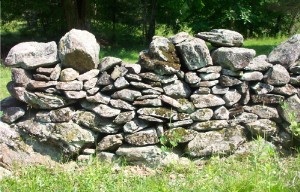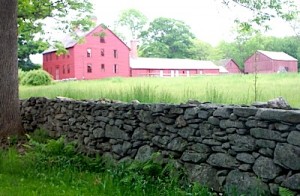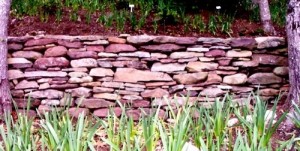Years ago, I started to use what I called the Snowplow Typology. This classification so simple that it could be done while doing another job, for example the snowplow driver plowing snow. Logical strategies for stone wall conservation might follow these basic distinctions.
ABANDONED WALLS

By abandoned, I mean walls that are no longer maintained. Such walls are no less wild than the wildlife that uses them for habitat or for cover. I define them using a subjective question: “If a stone fell down, what would you do? If you answer is to leave it in place, then the wall is abandoned. I suggest that you:
- Leave them be. They are busy being archaeology, being habitat, creating wetlands, and stabilizing surface soils.
- Minimize the number of cuts made through them for driveways, roads, gates. Each cut is like whittling away the past.
- When possible, align property edges of new subdivisions along these old lines. This will help preserve them through future land conveyances.
- Do not use them as a source of stone for other walls, especially if they are to be built off site.
HERITAGE WALLS

These walls are either historic sites in and of themselves, or they are adjuncts to one. Examples include the stone walls along the battle Road in Minuteman National Park in Concord and Lexington MA, the old sea-walls below the Cliff Walk in Newport RI, and the one shown above, those gracing the 1776 farmstead of Nathan Hale, in Coventry, CT. If a stone falls down, the general impetus is to put it back in its proper place. This makes it a heritage wall. I suggest that you…
- Identify and inventory all components of the wall or segments of walls. Each is equivalent to an archaeological site.
- Inventory them based on some naming protocol. I suggest the taxonomy of this website or the dichotomous key in Exploring Stone Walls.
- Decide who is responsible for taking care of each component on the inventory (some heritage walls cross several properties).
- Develop a plan for maintaining and protecting them that includes base-line photos and descriptions.
- Contact the local state Office of the State Archaeologist. This national association keeps track of them for you.
RECENT & REBUILT WALLS

This category captures all walls that were built from scratch with imported stone (recent), or completely rebuilt (or nearly so) with pre-existing stone during the modern era. For our purposes here, the time period “recent” roughly coincides with suburban expansion during the 1960s and the subsequent epoch of environmental conservation. A “recent” wall has no predecessor on site. A “rebuilt” one does. These two terms are the end members for what turns out to be a complete spectrum of walls, which is why I find it most useful to lump them together.
For future recent walls, meaning those built with imported stone:
- Recommend against the importation of stone strip-mined from old walls.
- Recommend building them following local folk-art traditions
- Encourage use of dry stone techniques.
- Discourage odd, turreted, or otherwise unusual walls that might be seen as garish or ostentatious.
For future rebuilt walls, meaning those built from the residues of an older wall on site.
- Encourage rebuilding one section at a time to maintain drystone habitat.
- Don not move stone too far.